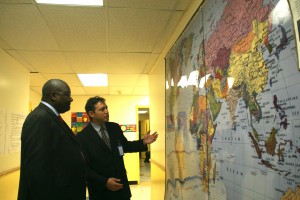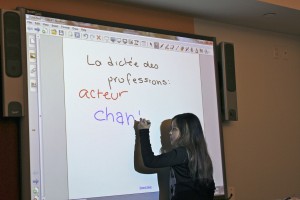The blue doors were wide open at the New York French American Charter School on a late April afternoon, as students, teachers, and administrators awaited a visit from an United Nations ambassador, who was just one of many high-profiled guests to come to the Harlem charter school since its opening two years ago.
The Harlem public charter school, the city’s first French-American charter school, was placed on probation last December for violations that included reportedly allowing a parent volunteer to sleep in the building overnight. The school is waiting to find out if the Department of Education will continue to place on probation next year, but that hasn’t stopped international guests from visiting or students from applying. Vanessa Handal-Ghenania, the school’s curriculum supervisor, said the school has a wait list for all its grades. Over 200 families applied for 50 spots in next year’s kindergarten class.
The school teaches French through immersion method, giving families who come from Francophone backgrounds the chance to maintain their cultural connections, said Principal Stephen Peters, who took over in February. Located at Manhattan Avenue and 120th Street, the school has a strong relationship with the city’s large West African community in central Harlem.
On the rainy afternoon, Peters and the school community cheerfully welcomed Ambassador Filippe Savadogo, the Permanent Observer of Francophonie to the United Nations, as he walked into the colorful classrooms at the Kindergarten through 3rd grade school. Francophonie is comprised of countries that speak French and promote French culture. The ambassador’s visit is just one of many ways the school reaches out to strengthen its Francophone ties across the city.

“I have to say bravo to you and say you have to continue to maintain what you are doing because you are doing well,” said Ambassador Savadogo, addressing the small crowd of school administrators. “What I saw this midi [noon] was children who are coming from cultural diversity.” The multicultural school boasts a student body represents nearly 88 different nationalities, with students coming from Harlem and all over the city, including Brooklyn and Queens.
“For a lot of these families, unless you could afford Lycée Français, this is the viable option for Francophone culture. I believe it’s a big draw for a lot of these families,” added Andrew Srulevitch, one of the school’s board members. Several families have moved to Harlem to be closer to the school, which is what Srulevitch did. His family moved from the Upper West Side to Harlem because his son is enrolled in first grade, and his daughter will start kindergarten in September.
The study of French in the United States has declined over recent years, falling by 3 percent from 2004-05 to 2007-08, according to a report commissioned by the American Council on the Teaching of Foreign Relations. During the same time period, students learning Chinese languages increased by 195 percent and over 70 percent of foreign language students are studying Spanish.
But in New York City, French is once again becoming a popular foreign language to learn, with classes offered at the French-American charter school, prestigious expensive private schools like Lycée Français, after school programs at the French Institute Alliance Française, and several public schools. The French embassy works with six public schools to support their dual language program.
While French is a gateway language for the city’s immigrant communities, other parents consider it to be an opportunity to set their children on a path towards an international lifestyle.
This is exactly what motivated Laura Obando to enroll her 11-year-old daughter, Crystal, in a beginner’s class at the French Institute Alliance Française on the Upper East Side. “I don’t believe a child should speak just one language in New York City. Everybody wants to speak two or three languages,” said Obando said.
The Obandos speak Spanish, but mother and daughter are now attempting to become polygots. Laura is learning Italian. “Since I’m in the fashion industry, I assume that either French or Italian will be good for her to continue her studies,” said the 30-year-old mother, who owns a clothing company based in Costa Rica. Crystal also studied German when she temporarily lived in Costa Rica.
Like the French-American charter school, the Alliance Française is witnessing a rise in enrollment according to Guitty Roustai, the Youth Program Director. “The children’s program has been increasing,” said Roustai. “Five years ago we had 35 kids. We have around 300 now,” she added, speaking about the toddler program, à petits pas.
Crystal’s teacher, Wassilya Imessaoudene, stressed that learning French is important simply because it’s still an international language. “You need it if you travel,” she explained. “Many institutions require French if you like to work at some big institutions like the United Nations. I think there are many different reasons to learn French – it’s one of the most useful languages, even for children.”

For Crystal and her mom, learning another language also invites them into a new social community. “I feel that when you learn a language, you are meeting a new friend,” said Laura. “You’re introducing yourself to a new culture, to new food, and to us, at least, that’s important.”
“I think it’s great because I just don’t want to speak English and Spanish, if I have a new friend that speaks French, I’d like to communicate with her,” the energetic 11-year-old piped in.
“There’s been an acceleration in the creation of French programs in the last five years in New York,” said Fabrice Jaumont, who works in the French Language Department for the French Embassy. “Because there’s so much talk about the benefits of bilingualism, we’re getting more interest.”
Jaumont, through the embassy, works with six city public schools as well as the French-American charter by helping them raise money to buy textbooks that are used in the French curriculum. The embassy also helps to send teachers to France in the summer for three weeks of language training before they come back to the United States to teach.
The results are paying off. Jaumont said public school principals that host the French program report that it helps boost test scores. The French embassy is helping two more public schools, one in Carroll Gardens and the other on the Upper West Side, to offer French next year.
“We really put an emphasis on bilingualism,” added Jaumont. “French is a passport to the world.”
* The original version incorrectly listed Stephen Peters as starting in March, not February.


